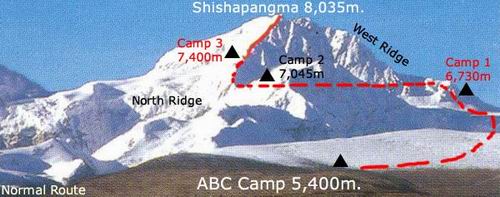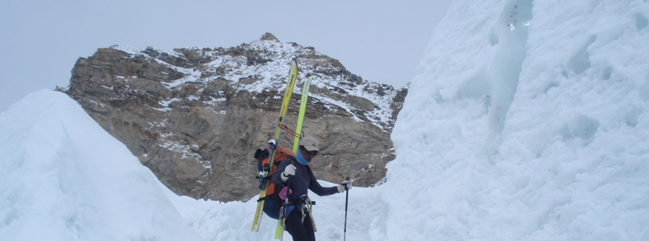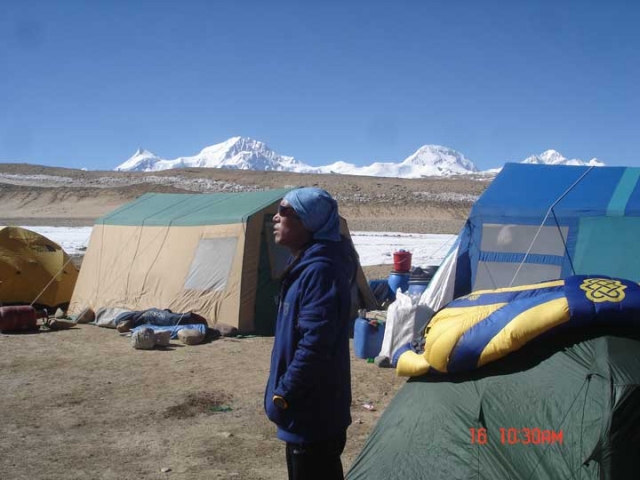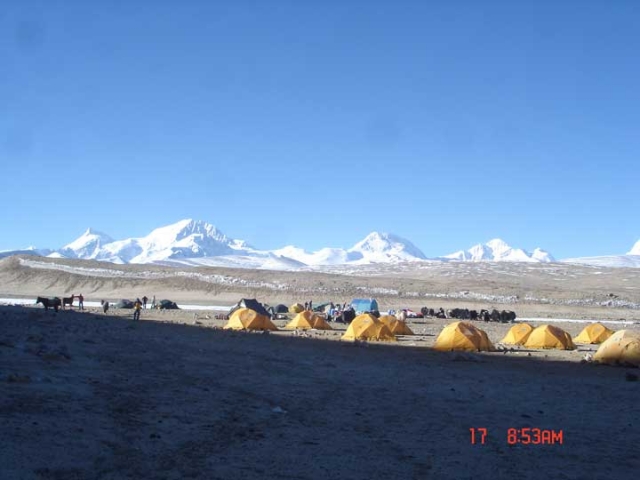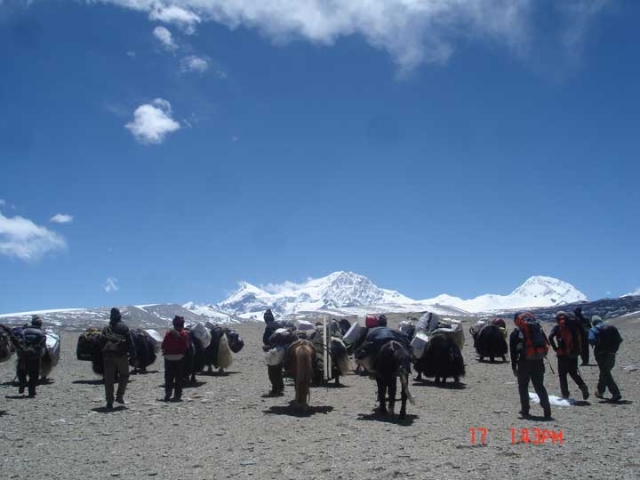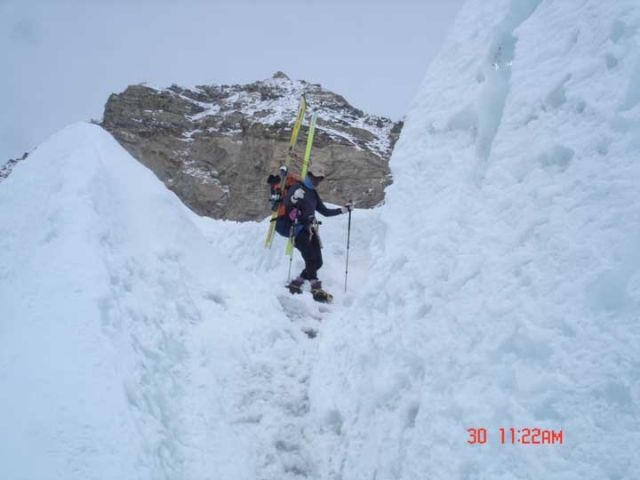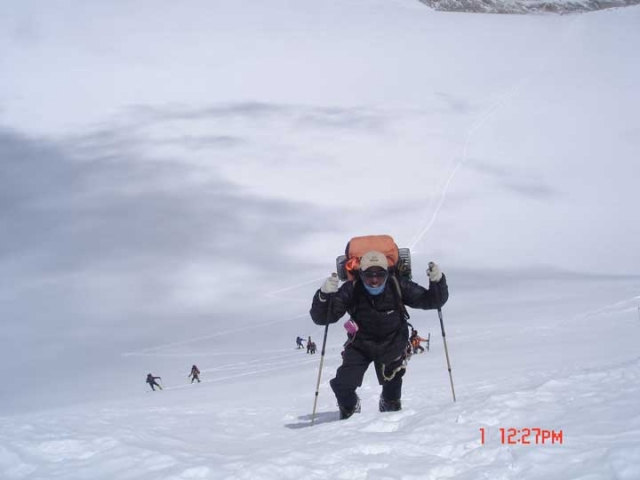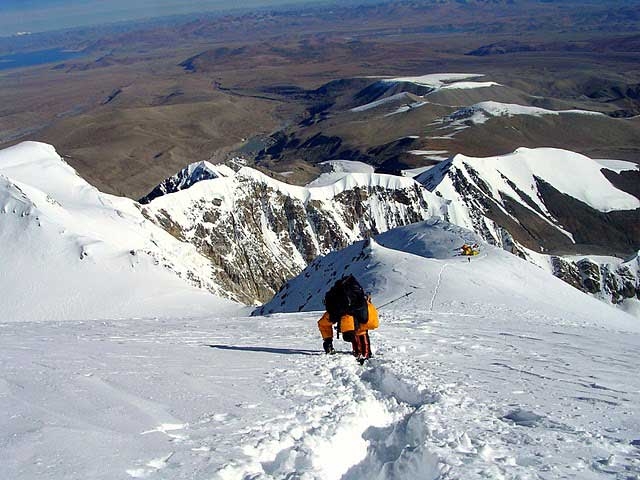Shishapangma officially Xixiabangma is the fourteenth highest mountain in the world and the lowest of the eight-thousanders. It was the last 8,000 meter peak to be climbed, due to its location entirely within Tibet and the restrictions on outside visitation to the region imposed by the Chinese during the 1950s and later. The mountain has two summits, the commonly climbed Central summit that the Chinese say is 8013m (7999m on old maps) which we have reached four times. Naturally, we will be aiming to climb to the higher true summit, 8027m (26,335ft), let’s see if we can get there!
Before the Chinese opened Tibet to western mountaineers in 1978, little was known about Shishapangma. The only 8,000m peak to lie entirely in Tibet, it lies tantalizingly close to the Nepalese border, shrouded behind the great, but less high, border peaks of Langtang. Enterprising individuals sought mere glimpses of it during the period that other 8,000m peaks were receiving their first ascents! It is perhaps not surprising that it was the last of the 8,000m peaks to be climbed. Not that its ascent by the North-West Ridge presents any great difficulty. On the contrary, it is now regarded as one of the most straightforward 8,000m climbs and its summit is frequently achieved.
Regarded as a ‘holy’ mountain by the local Tibetan population, and lying on the route to Mt. Kailash, Shishapangma continues to baffle us. Historians cannot fathom her names – Shishapangma, Xixabangma, Gosainthan. Yet, the mountain is perhaps the most accessible of her genre, rising only a few miles west of the Kathmandu-Lhasa Highway. It was 16 years before the mountain received its second ascent, by a West German team in 1980, and it has been climbed every year since.
Day 01- Arrival in Kathmandu Airport (1345meters).
There you will be met by our Airport Representative and transferred to hotel by private tourist vehicle. Overnight at hotel.
Day 02- Pre-trip Meeting and Sightseeing around Kathmandu valley.
In the morning after breakfast at 9 AM, we host a Pre-Trip meeting at your hotel in Kathmandu and introduced your expedition Leader/Guide and Sherpa team, at the same time it will provide an opportunity for individuals to ask questions about the your tour and to introduce you to other participants. This includes a final briefing and preparations for the trip.
PLEASE ADVISE US IF YOU WILL BE ARRIVING LATE AND ARE THEREFORE UNABLE TO ATTEND THE PRE-TRIP MEETING.
In THE PRE-TRIP MEETING All passengers MUST bring:
1. Passport.
2. Four copies of Passport size photos each.
3. Travel Insurance Policy.
4. A writing pen
5. Notepad.
After the Pre-Trip meeting and breakfast your sightseeing trip will start at 9.45 AM in the morning. We provide a private vehicle and professional tour guide. We visit Bodhnath Stupa, one of the biggest Buddhist shrines in the world, where we observe Buddhist monks in prayer in the monasteries surrounding the stupa. After Bodhnath Stupa we visit Pashupatinath, the most famous Hindu temple in the country, located on the banks of the holy Bagmati River. Here we see Hindu holy men (sadhus) meditating, pilgrims bathing and occasionally funeral pyres burning on the ghats. We also visit Bhaktapur Durbar Square, which is a collection of pagoda and shikhara – style temples grouped around a fifty-five-window palace of brick and wood. The attraction of the Bhaktapur Durbar Square is The Lion gate, The Golden gate, The Palace of fifty five windows, Art Galleries, The Statue of King Bhupatindra Malla.
The rest of our time in Kathmandu is free for further exploration and some last-minute shopping in Thamel area near by your hotel. Later, we are supplied with our Trip Pack and information for tomorrow. Overnight at hotel.
Day 03- Official formalities in Kathmandu.
Formal briefing in the Ministry of Tourism. Today, the expedition leader will also check everyone’s equipment. Overnight at hotel.
Day 04- Final Preparation day in Kathmandu. Overnight at hotel.
The last opportunity to buy anything missing.
Day 05- Fly from Kathmandu to Lhasa (3660meters). Overnight at hotel.
Early morning transfer to the international airport for the hour-long flight to Lhasa. This stunning flight, on a China Southwest Airlines Boeing 757, takes us right across the main Himalayan range and provides us with magnificent mountain views. After landing at Gongar Airport and meeting our local Tibetan Sherpa, it is a further 2-hour drive by Land cruiser to Lhasa. It’s advisable to rest and take it easy for the remainder of the day due to Lhasa’s altitude. Overnight at hotel.
Day 06- Sightseeing in Lhasa. Overnight at hotel.
We spend today visiting several of Lhasa’s many monasteries in the company of a guide and interpreter. One of these is the Sera Monastery, one of the best-preserved monasteries in Tibet, within its whitewashed walls and golden roofs, several hundred monks live and study. After lunch we’ll visit the Norbulingka, the summer palace of the Dalai Lama, as well as the Jokhang Temple. This temple is possibly the most sacred shrine in Tibet and there is always a procession of devout Tibetans through the complex. Surrounding the Jokhang is the Barkor – a maze of narrow cobbled streets that is the central market of Lhasa. Overnight at hotel.
Day 07- Second day of sightseeing in Lhasa. Overnight at hotel.
In the morning, we visit Potala Palace which dominates the city of Lhasa it’s a spectacular building, containing private quarters of the Dalai Lama as well as numerous grand state rooms and many important chapels. There has been a Palace on this site since the 5th or 6th century, but the present Palace was constructed in the 17th century. After lunch, we visit the Drepung Monastery, which was founded in the 14th century and was once the largest in the world, with a population of around 10,000 monks. These days that figure is down to several hundred, but there is still much here of interest as it was left relatively unscathed during the Cultural Revolution. Overnight at hotel.
Day 08- Drive to Shigatse (3900 meters), 6 hours. Overnight at hotel.
We set off in jeeps across the Tibetan plateau. Soon after leaving Lhasa, we reach the banks of the Tsang Po, which becomes the Brahmaputra River when it enters India. We drive up-stream for a while before turning southwest through barren desert-like valleys to reach Shigatse, Tibet’s second city. Overnight in a hotel.
Day 09- Drive to Xegar (4000 meters), 6 hours. Overnight at hotel.
As we continue along the Tibetan highway, the northern edge of the Greater Himalaya comes into view, often providing a spectacular panorama of peaks, including Everest. We overnight in a hotel 7 kilometers outside the main town of Xegar. If there is time, we may be able to visit the main town and its hilltop monastery.
Day 10- Acclimatisation Day. Overnight at hotel.
This is an important day which will help is cope with the big height gain to Chinese base camp tomorrow. The general advice is to take it easy, but a visit the main town and a gentle hike up to its hilltop monastery (4,200m) are highly recommended.
Day 11- Drive to Shishapangma base camp (5000 meters). Overnight at tented camp.
Magnificent views of Shishapangma and many other mountains make today’s road journey an unforgettable one. After crossing the Thang La (5,200meters) we turn off the Lhasa highway and head west along the road to Mount Kailash for a further 25 km. Turning south onto an even smaller track, we eventually arrive at base camp (5,000meters). This is situated close to the Yambughangala River, which drains the north side of Mt. Shishapangma.
Day 12 and 13- Base camp preparation. Overnight at tented camp.
Our first couple of days at base camp are spent preparing our equipment and organizing loads for the yaks to go up. These are also important days for our acclimatization, as we will all feel the effects of living at 5,000 meters and we need to be in good shape for the long route to advance base camp.
Day 14- Move to Advanced Base Camp (5600 meters). Overnight at tented camp.
After loading up the yaks with all of our equipment, we set off with them on the 12 mile/20 kilometer trek to advance base camp. Initially we follow a jeep track to a plateau above the river and then the west bank of the valley to ABC (Advance Base Camp) near the snout of the Yambughangala Glacier (5,600meters). This is in a very impressive situation, with the giant white pinnacles of the glacier leading up the valley to Shishapangma. Here we unload the yaks and set up the camp, which is the take-off point for the climb. From here the Sherpas have to do most of the load carrying.
Day 15 to 40- Climb period of Shishapangma.
Above Advance Base Camp we will place two or three camps depending on conditions. The climb starts with a long traverse leading to a large camping area at 6,400meters. From here we traverse further, gaining a lot of height, to reach the shoulder of the mountain and camp 2 (7,100meters). All of the climbing is on scree or snow and presents little difficulty. The North-West Ridge is easily reachable from camp 2, although it may involve snow and ice climbing up to 50° steep. Fixed ropes are placed on all steep/crevassed sections. If a high camp is required, it is placed according to the prevailing conditions. The summit ridge is very long and it is usual to take a rising diagonal line across the snow slope below it to reach the ridge as close to the summit as possible. The West Summit (8,008meters) of Shishapangma is quicker to reach than the main summit and is the usual point reached by ‘summiteers’. Plenty of time has been allowed in case of bad weather and slow acclimatization. We intend to have enough time at the end of the expedition to make a complete withdrawal from the mountain, removing all equipment and rubbish and taking it back to ABC.
Climb
The expedition leader in discussion with the team members and sherpas manages the day to day running of the expedition. The sherpas carry the majority of the equipment to establish the camps leaving us to familiarize ourselves with the mountain and get more acclimatized, a long process. There are several different methods to ready for yourself for the summit bid, we will discuss them in detail on the mountain.
The basic plan is to spend 3-4 days at ABC then take a 6-7 day trip up on the mountain sleeping as high as Camp two, 7100m. Logistically, it takes some sound preparation and organization to ensure all the camps are set up with the appropriate supplies. Then we need a window of good weather for the summit attempt and often this is a waiting game.
Summit route options
Summit day means a very early start. The best route to the true summit is crossing the face (in green above, and the picture to the right) but we judge at the time whether this is safe.
The route in yellow goes first to the Central summit, which we must fix, ropes too. From there to the true summit is a knife-edged ridge that is rarely in condition for traversing, although it is only nasty for less than a rope length.
The other possibility is a new route (in blue): from Camp 3 we descend a little onto a broad plateau and will probably have to put a camp there. The slopes from there on are moderate although there are a few crevasses.
Safety and the Conduct of the Climb
Many people have now climbed Shishapangma, the mountain and its potential dangers deserve respect by all those attempting it. Reaching the summit late in the day would be a serious mistake and our guides will ensure that sensible timings are adhered too. The aim of our expedition will be to get as many team members as possible to the summit. However, this will not be to the detriment of safety. Safety will govern all decision making on the mountain and will be based on the sound mountaineering judgment of our highly experienced mountain guides. To support our guides on the mountain, we at Ace the Himalaya will plan the expedition as thoroughly and carefully as possible using our own experience and knowledge of the mountain to maximum benefit. Ultimately, the leader will have sole discretion on the implementation of any plan to climb the mountain and he will ensure that safety remains the prime consideration.
The high mountains of the Himalaya, and Shishapangma in particular, are there for us to climb and to enjoy. Our priority will be to enable all team members to fulfill their potential on the mountain and to come home safely having had a life enhancing experience. Whether or not expedition members reach the top, the expedition should be an enjoyable and rewarding achievement that will form the basis of many long cherished memories and friendships.
Day 41 and 42 – Cleaning the mountain.
It takes several days to clear all the camps, and bring all our rubbish down.
Day 43- Packing Advance base camp.
More packing! Occasionally we can arrange for the climbers to leave ahead of the expedition leader and sherpas. We judge at the time.
Day 44- Trek Base Camp and drive Zhangmu. Overnight at guesthouse.
We trek to Base Camp then get the truck and Land cruisers there in the afternoon, heading to Zhangmu. Back to thicker air.
Day 45- Drive back to Kathmandu. Overnight at hotel and it’s time for celebration.
We should arrive in Kathmandu late afternoon or evening ready to enjoy the good restaurants.
Day 46- At leisure in Kathmandu. Overnight at hotel.
Time for a relaxing and shopping and to celebrate the expedition. K2 Summit Trek & Expedition will host an evening barbecue to celebrate the expedition and as a farewell party to thank the Sherpas and the team member for their support and friendship during the expedition with the hope of seeing you all again for next expedition, may be Everest!!
Day 47- Transfer to international airport for your final departure.
The trip ends, our Airport Representative will drop you to the Kathmandu international airport for your final flight departure from Nepal.
PLEASE NOTE: The above itinerary is not a fixed program but is intended to give an indication of the likely events during the expedition. Please note that because of climbing above 8000 meters, it will be necessary to have a flexible plan in order to take the best advantage of situations as they present themselves. Any changes to the itinerary will be made with a view to maximizing the benefit to the team members and of ensuring their eventual success on the mountain.
Normally climbers will change their departure flights from Kathmandu when they know exactly when the expedition is going to end. We plan to stay at Base Camp for climbing as long as it takes us to be successful.
Team members should take out private insurance if they wish to be covered against cancellation due to medical or personal reasons. This is called trip Cancellation insurance and can be obtained from your normal travel agent.
Our Philosophy
Our aim is to safely help as many team members as possible reach their goal, and we invest in the people and equipment that will make this happen. We value our reputation as the premiere climbing company in Himalayas and we only put programs in place that measure up to our own high standards. If you would like to join an excellent team on Shishapangma, we encourage you to contact us to discuss your goals and qualifications and secure an exciting role for yourself on our team.
Medical Cover
All of our local leaders are trained in first aid and have a good knowledge of high altitude medical problems. The expedition will be equipped with the following:
-A well stocked first aid and medical kit sufficient to counter any possible mountaineering ailments, from headache to serious injury.
-Oxygen equipment for medical use only.
-A portable hyperbaric chamber (Gamow bag)
-Emergency communications on the mountain and satellite communications link for helicopter evacuation.
Communications
Experience has shown how important it is to be able to talk to every team member, at all times. If you join Ace the Himalaya on Shishapangma expedition, you will have a dedicated radio. Each Sherpa will also have his own radio, so that at all times we can keep in touch with everyone, and everyone can keep in touch with each other.
We have an extremely good working relationship with the Helicopter Rescue Service, which means that an aircraft can be in the air immediately. Base Camp is equipped with a lap top and high speed satellite connection. The satellite communications are also used to send back regular reports, every couple of days, to Ace the Himalaya office. Expedition updates are then posted on the web and/or are sent to family and friends via email.
Oxygen & Rregulators
The amount of oxygen available to each team member has a direct bearing on the overall success of an expedition. The quantities will provide enough oxygen for every member to sleep on it from 7,000m and to use it to climb from there to the summit and back again. The Sherpas will also be using oxygen on summit day and for sleeping and working on and around. If you are unsuccessful in your first attempt at the top, then we will ensure that you have enough oxygen for another go.
We will be using lightweight oxygen bottles throughout the expedition, manufactured by Poisk. The Poisk bottles are without doubt the best available for mountaineering, as they have a proven track-record and are relatively light. The regulators are also manufactured by Poisk.
Marketing
While the official name of the expedition will remain the “Ace Shishapangma Expedition “, you can use another name for personal marketing purposes if it will assist you in any way. You will also be completely free to enter into personal agreements with sponsors or supporters if you choose.
Passport Photographs
Expedition members will need to provide 6 passport-size photographs for various climbing and trekking permits.
Sherpas
Sherpas are the indigenous people who were born in the Himalayas, reared in the Himalayas, involved in the occupation like climbing and mountaineering. Our Sherpa team has dozens of 8000 meters summits between them. We have a legendary group of Climbing Sherpas who operate the expedition and its members in a harmonious atmosphere of cooperation and commitment. Our group of climbing Sherpas is enthusiastic, motivated and regarded as the strongest and most cohesive group of Sherpas of Himalayas. It is indicative of the reputation that our Sherpa team has earned – that Sherpas from other expeditions enthusiastically pursue a future position with the Ace the Himalaya Team.
Our cooking staffs are very well known for the quality of the cuisine they produce and as a consequence are coveted by other team leaders due to the reputation they have established.
Additional climbing Sherpa
In our normal expedition you carry your personal equipment; sleeping bag, mattress/s, down suit, snacks, clothing while the sherpas carry the meals, gas, stoves, tents and oxygen. The team climbs together between camps and a climbing sherpa will also accompany you to the summit. This is a good level of service, and suits most people, however if you want an additional climbing sherpa to assist with your personal equipment and to climb with you all the time, we can provide.
Website updates
We provide updates using our own website so regardless of whether you have your own or not your family and friends will know what is happening.
Q. I want to climb for Expedition, but there are so many options and the cost is high! Why should I choose Kiwi Adventures Treks & Expedition ? What makes you different to other companies out there?
A. As we all know that when you make a decision to climb for expedition, it is one of the most financially challenging trips to come on. Our prices compared to other outfitters that provide the same product, services, if not a lesser product are actually less! We invite you to shop around and compare, both in price and quality. We feel strongly that you will find us to be the best in the business.
One of the main things that set us apart is our attention to detail. Nowhere else you will find a team of people more dedicated to your success! From the time you contact the office to the time you step on the mountain, our customer service is the best.
Our trip prices are much more reasonable compare to many global based companies; it is not because we are economical in service in which we operate. We are local operator therefore we DO NOT re-sell or use second party or agency. Many international companies will take anything from one third to three quarters of the profits this is how your trip price makes huge unusual.
Q. How the Expedition will operate?
A. After meeting all your team and crew in Kathmandu we fly by helicopter, drive by vehicle or fixed wing plane directly to the destination and then we start for trekking. Acclimatizing along the way and relishing in the hospitality provided by our Sherpa friends we reach base camp and after some rest and preparation we begin the ascent. Base camp will be a collection of sleeping tents, as well as a large kitchen and dining tent. We utilize the services of specially trained Sherpa cooks and we import a lot of high quality food to supplement the local produce available. The guides and Sherpas will fix rope on the route and stock the camps with provisions and equipment. By utilizing fixed rope we can climb in average weather, and, if necessary descend to base camp with little problem in case of a major storm. Two or three climbing Sherpas will assist with the load carrying but no more will be engaged in order to avoid clogging the route and spoiling the nature of the climb. When the fixed line is in place, and the two camps are established and stocked, we will climb back up the ropes and make a bid for the summit. Sufficient supplies will be available to support all members. Guides and Sherpas will carry all group gear but members are expected to carry their own personal gear. Radios will be used to co-ordinate the movements on the mountain and provide a safety back-up for the lead team.
Q. Can my friends and family come along to base camp for the expedition?
A. Sure! This is one of the best points to start the expedition, having family and friends trek to base camp to see you off on your journey. Base camp for non-climbers is not a very hospitable place, but we strive to make your guests comfortable and welcome. Guests for the duration of the expedition are allowed on a case by case basis. The reason for this is simple. On the trip, our job is to be climbing, spending time just at base camp can be quite boring sometimes, so we usually encourage guests to trek in at the beginning or end of the expedition, to join you during the most exciting parts of the trip! Contact us for cost and details.
Q. As the trip is so long, can I bring food and other gear not on the list?
A. Of course! Most people on the Expedition, members end up bringing “the kitchen sink”! We encourage you to bring some of your favorite goodies and tech toys, as base camp will become our home for 2 months or so. The more comfortable you are, the more energy you have for the climb, so every little thing helps!
Q. Is there a private trip option too? If yes, how does that work and what are the costs?
A. Doing Expedition is a once in a lifetime experience, we wanted to make sure you have every possible advantage. Some clients enjoy the added privacy and schedule flexibility that a private expedition allows. A private means you will have your own guides, your share of the Sherpa carry staff, a private dining tent, and optional private communication facilities. This allows you to climb at your own pace, and enjoy the mountain on your own terms. The costs vary depending on how many clients there are in your private group. Please contact the office for details.
Q. Are the skills/prior experiences required for this climb?
A. Simply, You cannot just decide to write a cheque and go and climb for Expedition ! A comprehensive climbing resume is required to join our team. The most required factor on our ‘Kiwi Adventures Treks & Expedition’ is that the participants must have a solid understanding of mountaineering skills. This should include previous high altitude experience of at least 6,000 meters, mixed with a multitude of Alpine mountaineering and, preferably, you will have taken part in a previous 8,000-metre expedition. Please let us know if you want us to arrange training program in some of the 6000 and 7000 meters peaks in Himalaya before your expedition begin.
Q. What is the conditioning level needed for this climb?
A. You should be in the best shape of your life! This is our longest expedition of the year. It requires patience, stamina, mental fortitude, and a strong will. Summit day can sometimes be over 20 hours long! Day by day the challenges are different, but the more prepared you are, both mentally and physically, the smoother your trip will go.
Q. In a team, how many climbers will be on this expedition?
A. Maximum 10 members can be included on our Kiwi Adventures Treks & Expedition. This is to ensure that we can maintain safety and our attention on detail. There may be more in base camp and in the camps on the mountain if there are private expeditions, but they will generally travel separately from the main team.
Q. Will I be sharing a tent or room with other climbers? Is there a single room option on this trip?
A. You will have your own tent in base camp, but on the mountain, you will be sharing a tent with others. We generally book you in to a single room in the hotel in Kathmandu whilst it is twin share in the lodges on the trek into base camp. A single supplement is available. Please contact us for further details.
Q. How heavy will my pack be?
A. It will depend on the day. On a “carry” day, where you are moving your personal gear between camps, your pack can be 20-40lbs, equal to 9-18kg , sometimes higher if you choose to carry more of your equipment. On “move” days, the weight goes down significantly, to 10-15lbs., 5-7kg.
Q. What kind of food do you have on the mountain? Or at the base camp?
A. All these will depend on what camp we are in. In the base camp, we import tons of food from Kathmandu. So don’t be surprised by our sushi nights, fresh muffins, yoghurt for breakfast, and pizza! On the mountain, we usually have a wide variety of meals; these are significantly tastier than freeze dried, as they are real food and ready to heat and eat! At Camp 2, our advanced base camp, we have Sherpa cook staff, who prepare more ‘base camp like’ food. Pizza, pasta, eggs and bacon! We work hard to make sure our food is second to none.
Q. How long will be a typical day on the mountain?
A. It depends on the day and your level of acclimatization. At the beginning of the trip, everything seems slower and longer, but as you get more adjusted to the mountain, the days go quicker. Average days can be 5-10 hours long. Summit day can be up to 20 hours long.
Q. Is communication possible on the expedition? If yes, what its type?
A. Experience has shown how important it is on expedition to be able to talk to every team member, at all times. If you join Kiwi Adventures Treks & Expedition on expedition, you will have a dedicated radio. Each Sherpa will also have his own radio, so that at all times we can keep in touch with everyone, and everyone can keep in touch with each other.
Base Camp is equipped with a lap top and high speed satellite connection. The satellite communications are also used to send back regular reports, every couple of days, to Kiwi Adventures Treks & Expedition office.
Q. What sort of hotels do we stay at in the city?
A. We use standard rooms from three/four star hotels in Kathmandu with breakfast included.
Q. What time should I arrive and where do I meet my guides?
A. There will be an Kiwi Adventures Treks & Expedition representative at the airport to meet you, and the first of many team briefing occurs in the evening of day 1 and 2 in Kathmandu with our local Sherpa guides.
Q. How much should I budget for this expedition? How much cash should I plan to bring?
A. Since this is our biggest and longest trip, we usually suggest our expedition members to bring USD$2000 -$3000. This will cover everything from gifts, to bottled drinks, tips, and anything else that catches your eye on the trail. ATM cash machines work in Kathmandu, but only pays the local currency, Rupees.
Q. How much should I tip my guide staff?
A. This is a difficult thing to gauge. We have seen everything from 100USD to 15,000USD for an Expedition tip. Tipping is not required, but a small way to show your guides thanks for their help. The level of the tip should reflect the level of personal involvement with your guide.
The suggested tipping are as follow:
– Allow $150-250 for general non-sherpa crew who stay at base camp.
– Allow $200-350 for sherpas who go up to the base camp.
– Summit climbing Sherpa US$ 1000 – 1500 per Sherpa.
Q. What if I arrive early or depart late?
A. As long as possible, we request you to arrive in Kathmandu on the assigned date, to assure your baggage makes it on time, and you have time to recover from jet lag before trekking. It is hard to catch the group if you are arriving late and still waiting for lost baggage! We can arrange extra nights in the hotel. Many people depart from our Nepal expeditions later, to enjoy the sights and sounds of Kathmandu, but do keep in mind that this is long expedition and we find that people want to head home as quickly as possible after the climb finishes.
Q. Are there any entry or visa requirements?
A. Yes there are. Be sure to have the suggested USD amount in cash for your visa application and have a passport, photos for your arrival in Kathmandu. You will receive your visa at the airport, and we will add extra days later, as you are only ever issued a 90 days visa when you first arrive.
Q. Could I have my own personal Sherpa?
A. In our normal expedition you carry your personal equipment; sleeping bag, mattress/s, down suit, snacks, clothing while the sherpas carry the meals, gas, stoves, tents and oxygen. The team climbs together between camps and a climbing sherpa will also accompany you to the summit. This is a good level of service, and suits most people, however if you want an additional climbing sherpa to assist with your personal equipment and to climb with you all the time, we can provide. Please contact us.
Q. What kind of insurance do I need?
A. We invest in insurance coverage for commercial liability and medical and disability insurance for our employees and Sherpas while participating on our programs. We cannot insure you for your personal needs, but we do expect you to be as fiscally responsible as we are. We strongly recommend that you insure yourself against potentially expensive difficulties that may arise. First, trip cancellation insurance may provide financial relief should you be forced to withdraw from the climb before it even happens. Next, make sure you have adequate traveler’s medical and evacuation insurance for coverage should you have a problem during the trip. Medical care and evacuation from mountain can be expensive.
For the Rescue and Evacuation, Kiwi Adventures Treks & Expedition strongly recommends that you purchase a Global Rescue membership to protect yourself and your family. We give you our word that you will be safer as a result. We are an authorized agent of Global Rescue, click here to sign up the membership plan today.
Q. Are the Kiwi Adventures Treks & Expedition staff insured?
A. Our company insures all our trekking staff, including guide, cook, sherpa and porters.
Q. Can’t find your question here?
A. Contact us for further information!
Cost Includes
• Airport / Hotel / Airport pick up & drop by private car / van / bus.
• Standard twin sharing accommodation in three/four star hotel in Kathmandu breakfast included. (6 nights)
• Guided city tour in Kathmandu by private car / van / bus.
• Full board meal during the tour/trek and camping at base camp, prepared by our cook with hot Tea & coffee.
• All base camp and Advance base camp camping gears (We will provide fully water proof dining tents, kitchen gears, dining table, chairs, toilet tents, shower tent at the base camp and advance base camp)
• High quality tents for all camps.
• Insurance for all Nepali staffs and porters including helicopter rescue provision.
• Boiled and purify drinking water for the trek and at base camp.
• Expedition permits
• Liaison officer and his round trip flight, insurance, wages, expedition equipments etc.
• High altitude climbing food, fuel, Gas above base camp (you are also advised to bring some high altitude food yourselves)
• Guide, cook, porters, helpers up to base camp
• Climbing Sherpas (1 member = 1 Sherpa Ratio on climbing day)
• A well stocked first aid and medical kit sufficient to counter any possible mountaineering ailments, from headache to serious injury.
• Oxygen equipment for medical use and summit (from 7,000m) only.
• A portable hyperbaric chamber (Gamow bag)
• Emergency communications on the mountain and satellite communications link for helicopter evacuation..
• Mask regulator
• Sightseeing/Monument entrance fees.
• Welcome and farewell dinner for members in Kathmandu.
• Power supply at Base Camp for charging electronics (solar or generator backup)
• Flight cost from Kathmandu – Lhasa including airport departure tax.
• Chinese visa and permit. (We handle all the paperwork for the Chinese visa and all the Tibet travel and climbing permits.)
• All our government taxes and vat.
Cost Excludes
• Lunch and dinner whilst in Kathmandu and in Lhasa.
• Travel Insurance which cover emergency Rescue and Evacuation. (K2 Summit Treks & Expedition strongly recommends that you purchase a Global Rescue membership to protect yourself. We are an authorized agent of Global Rescue. Read about our emergency helicopter RESCUE & SECURITY EVACUATION Policy)
• International airfare and airport departure tax.
• Nepal entry visa fee (Tourist Visa with Multiple Entry for 90 days can be obtained by paying US $ 100 in Kathmandu airport up on your arrival. You will also require 2 passport size photos You can easily extend the visa if require.)
• Items of a personal nature such as alcoholic drinks, cold drinks, laundry.
• Personal trekking and Climbing Equipment.
• Any others expenses which are not mentioned on Price Includes section.
• Excess baggage charges.
• Sherpa tip pool (See below)
• Internet and sat phone.
• Costs incurred as a result of delays or events beyond the control of K2 Summit Treks and Expedition
